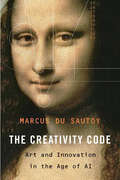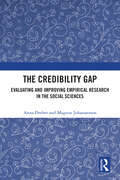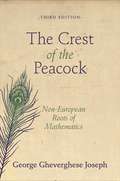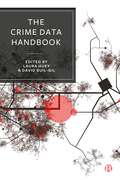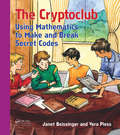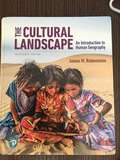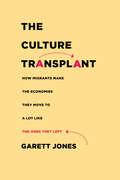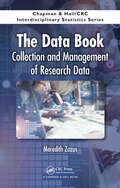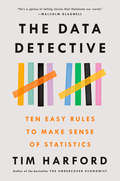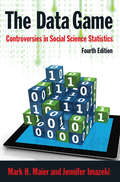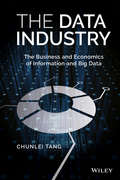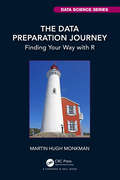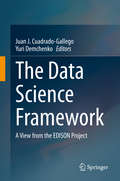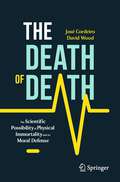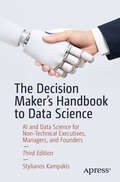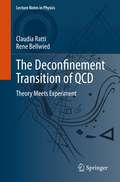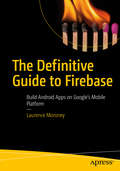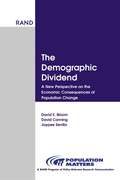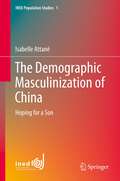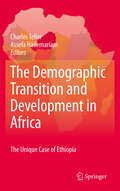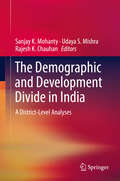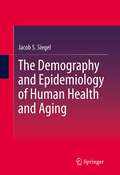- Table View
- List View
The Creativity Code: Art and Innovation in the Age of AI
by Marcus du SautoyMost books on AI focus on the future of work. But now that algorithms can learn and adapt, does the future of creativity also belong to well-programmed machines? To answer this question, Marcus du Sautoy takes us to the forefront of creative new technologies and offers a more positive and unexpected vision of our future cohabitation with machines.
The Credibility Gap: Evaluating and Improving Empirical Research in the Social Sciences
by Anna Dreber Magnus JohannessonWhich scientific results can we trust? This question has been brought to the forefront of research in the social sciences in recent years with the movement towards open science practices and preregistration. Systematic replication studies of laboratory experiments in the social sciences have found that only about half of the “statistically significant” results published in top journals can be replicated in the sense that similar results are achieved with new data. This low replicability may be even lower in studies based on observational data as such studies have more degrees of freedom in the analysis of the data leading to larger possibilities to selectively report more publishable findings.In this book, the authors provide a framework for evaluating reproducibility, replicability and generalizability of empirical research in the social sciences. They define different types of reproducibility and replicability and show how they can be measured to evaluate the credibility of published findings. Different approaches to improving the credibility of published findings, such as preregistration with detailed pre-analysis plans, Registered Report publications, and preregistered prospective meta-analysis are also outlined and discussed. Even if published results are not systematically biased, the variation in results across populations, research designs, and analyses decreases the reliability and generalizability of published findings. The book shows how such heterogeneity in results can be measured and incorporated in the analysis to more accurately represent the uncertainty and thereby generalizability of reported results.
The Crest of the Peacock
by George Gheverghese JosephFrom the Ishango Bone of central Africa and the Inca quipu of South America to the dawn of modern mathematics, The Crest of the Peacock makes it clear that human beings everywhere have been capable of advanced and innovative mathematical thinking. George Gheverghese Joseph takes us on a breathtaking multicultural tour of the roots and shoots of non-European mathematics. He shows us the deep influence that the Egyptians and Babylonians had on the Greeks, the Arabs' major creative contributions, and the astounding range of successes of the great civilizations of India and China. The third edition emphasizes the dialogue between civilizations, and further explores how mathematical ideas were transmitted from East to West. The book's scope is now even wider, incorporating recent findings on the history of mathematics in China, India, and early Islamic civilizations as well as Egypt and Mesopotamia. With more detailed coverage of proto-mathematics and the origins of trigonometry and infinity in the East, The Crest of the Peacock further illuminates the global history of mathematics.
The Crime Data Handbook
by Mark Mills Rosemary Barberet Nicholas Lord Jude Towers Alex Sutherland Craig Bennell Lisa Tompson Jack Cunliffe Henk Elffers Kirsty Bennett Stuart Thomas Anthony Morgan Scott Keay Alexandru Cernat Ian Brunton-Smith Tim Verlaan Sam Langton Sophie Curtis-Ham Sarah Czarnomski Jesús C. Aguerri Fernando Miró-Llinares Tomas Diviak Tori Semple Bryce Jenkins Angelo Moretti Jose Pina-Sanchez Thiago R. Oliveira Leticia Couto Marta Murrià Sangenís Cristina Sobrino Garcés Timothy I. Cubitt Nico Trajtenberg Olga Sanchez de Ribera de Castro Carly Lighttowlers Lucy Bryant Olivia Horsefield Francisco J. Castro-Toledo Ana B. Gómez-Bellvís Sara Correia-Hopkins José María López Riba Raquel Bartolomé Gutiérrez Esther Fernández-MolinaCrime research has grown substantially over the past decade, with a rise in evidence-informed approaches to criminal justice, statistics-driven decision-making and predictive analytics. The fuel that has driven this growth is data – and one of its most pressing challenges is the lack of research on the use and interpretation of data sources. This accessible, engaging book closes that gap for researchers, practitioners and students. International researchers and crime analysts discuss the strengths, perils and opportunities of the data sources and tools now available and their best use in informing sound public policy and criminal justice practice.
The Crossing of Heaven
by Karl Gustafson Ioannis AntoniouAmong the group of physics honors students huddled in 1957 on a Colorado mountain watching Sputnik bisect the heavens, one young scientist was destined, three short years later, to become a key player in America's own top-secret spy satellite program. One of our era's most prolific mathematicians, Karl Gustafson was given just two weeks to write the first US spy satellite's software. The project would fundamentally alter America's Cold War strategy, and this autobiographical account of a remarkable academic life spent in the top flight tells this fascinating inside story for the first time. Gustafson takes you from his early pioneering work in computing, through fascinating encounters with Nobel laureates and Fields medalists, to his current observations on mathematics, science and life. He tells of brushes with death, being struck by lightning, and the beautiful women who have been a part of his journey.
The Cryptoclub: Using Mathematics to Make and Break Secret Codes
by Janet Beissinger Vera PlessJoin the Cryptokids as they apply basic mathematics to make and break secret codes. This book has many hands-on activities that have been tested in both classrooms and informal settings. Classic coding methods are discussed, such as Caesar, substitution, Vigenère, and multiplicative ciphers as well as the modern RSA. Math topics covered include: - Addition and Subtraction with, negative numbers, decimals, and percentages - Factorization - Modular Arithmetic - Exponentiation - Prime Numbers - Frequency Analysis.The accompanying workbook, The Cryptoclub Workbook: Using Mathematics to Make and Break Secret Codes provides students with problems related to each section to help them master the concepts introduced throughout the book. A PDF version of the workbook is available at no charge on the download tab, a printed workbook is available for $19.95 (K00701). The teacher manual can be requested from the publisher by contacting the Academic Sales Manager, Susie Carlisle
The Cultural Landscape: An Introduction to Human Geography
by James M. RubensteinThe Cultural Landscape: An Introduction to Human Geography uses a structured learning path to look into the patterns and processes of Earth's human landscapes. Rubenstein explores the relationships between people and their locations, looking at where people and activities are located across Earth's surface and understanding why they are located in particular places.
The Culture Transplant: How Migrants Make the Economies They Move To a Lot Like the Ones They Left
by Garett JonesA provocative new analysis of immigration's long-term effects on a nation's economy and culture. Over the last two decades, as economists began using big datasets and modern computing power to reveal the sources of national prosperity, their statistical results kept pointing toward the power of culture to drive the wealth of nations. In The Culture Transplant, Garett Jones documents the cultural foundations of cross-country income differences, showing that immigrants import cultural attitudes from their homelands—toward saving, toward trust, and toward the role of government—that persist for decades, and likely for centuries, in their new national homes. Full assimilation in a generation or two, Jones reports, is a myth. And the cultural traits migrants bring to their new homes have enduring effects upon a nation's economic potential. Built upon mainstream, well-reviewed academic research that hasn't pierced the public consciousness, this book offers a compelling refutation of an unspoken consensus that a nation's economic and political institutions won't be changed by immigration. Jones refutes the common view that we can discuss migration policy without considering whether migration can, over a few generations, substantially transform the economic and political institutions of a nation. And since most of the world's technological innovations come from just a handful of nations, Jones concludes, the entire world has a stake in whether migration policy will help or hurt the quality of government and thus the quality of scientific breakthroughs in those rare innovation powerhouses.
The Curve Shortening Problem
by Kai-Seng Chou Xi-Ping ZhuAlthough research in curve shortening flow has been very active for nearly 20 years, the results of those efforts have remained scattered throughout the literature. For the first time, The Curve Shortening Problem collects and illuminates those results in a comprehensive, rigorous, and self-contained account of the fundamental results.The a
The Data Book: Collection and Management of Research Data (Chapman & Hall/CRC Interdisciplinary Statistics)
by Meredith ZozusThe Data Book: Collection and Management of Research Data is the first practical book written for researchers and research team members covering how to collect and manage data for research. The book covers basic types of data and fundamentals of how data grow, move and change over time. Focusing on pre-publication data collection and handling, the text illustrates use of these key concepts to match data collection and management methods to a particular study, in essence, making good decisions about data. The first section of the book defines data, introduces fundamental types of data that bear on methodology to collect and manage them, and covers data management planning and research reproducibility. The second section covers basic principles of and options for data collection and processing emphasizing error resistance and traceability. The third section focuses on managing the data collection and processing stages of research such that quality is consistent and ultimately capable of supporting conclusions drawn from data. The final section of the book covers principles of data security, sharing, and archival. This book will help graduate students and researchers systematically identify and implement appropriate data collection and handling methods.
The Data Detective: Ten Easy Rules to Make Sense of Statistics
by Tim HarfordFrom &“one of the great (greatest?) contemporary popular writers on economics&” (Tyler Cowen) comes a smart, lively, and encouraging rethinking of how to use statistics.Today we think statistics are the enemy, numbers used to mislead and confuse us. That&’s a mistake, Tim Harford says in The Data Detective. We shouldn&’t be suspicious of statistics—we need to understand what they mean and how they can improve our lives: they are, at heart, human behavior seen through the prism of numbers and are often &“the only way of grasping much of what is going on around us.&” If we can toss aside our fears and learn to approach them clearly—understanding how our own preconceptions lead us astray—statistics can point to ways we can live better and work smarter.As &“perhaps the best popular economics writer in the world&” (New Statesman), Tim Harford is an expert at taking complicated ideas and untangling them for millions of readers. In The Data Detective, he uses new research in science and psychology to set out ten strategies for using statistics to erase our biases and replace them with new ideas that use virtues like patience, curiosity, and good sense to better understand ourselves and the world. As a result, The Data Detective is a big-idea book about statistics and human behavior that is fresh, unexpected, and insightful.
The Data Game: Controversies in Social Science Statistics (Habitat Guides)
by Mark Maier Jennifer ImazekiThis book introduces students to the collection, uses, and interpretation of statistical data in the social sciences. It would suit all social science introductory statistics and research methods courses. Separate chapters are devoted to data in the fields of demography, housing, health, education, crime, the economy, wealth, income, poverty, labor, business statistics, and public opinion polling, with a concluding chapter devoted to the common problem of ambiguity. Each chapter includes multiple case studies illustrating the controversies, overview of data sources including web sites, chapter summary and a set of case study questions designed to stimulate further thought.
The Data Industry: The Business and Economics of Information and Big Data
by Chunlei TangAn introduction of the data industry to the field of economics This book bridges the gap between economics and data science to help data scientists understand the economics of big data, and enable economists to analyze the data industry. It begins by explaining data resources and introduces the data asset. This book defines a data industry chain and enumerates data enterprises' business models, operating models, and developing models. The author describes five types of enterprise agglomerations, and multiple industrial cluster effects. A discussion on the establishment and development of data industry related laws and regulations is provided. In addition, this book discusses several scenarios on how to convert data driving forces into productivity that can then serve society. This book is designed to serve as a reference and training guide for data scientists, data-oriented managers and executives, entrepreneurs, scholars, and government employees. Defines and develops the concept of a "Data Industry," and explains the economics of data to data scientists and statisticians Includes numerous case studies and examples from a variety of industries and disciplines Serves as a useful guide for practitioners and entrepreneurs in the business of data technology The Data Industry: The Business and Economics of Information and Big Data is a resource for practitioners in the data science industry, government, and students in economics, business, and statistics. Chunlei Tang, Ph.D., is a research fellow at Harvard University. She is the co-founder of Fudan's Institute for Data Industry and proposed the concept of the "data industry". She received a Ph.D. in Computer and Software Theory in 2012 and a Master of Software Engineering in 2006 from Fudan University, Shanghai, China.
The Data Preparation Journey: Finding Your Way with R (Chapman & Hall/CRC Data Science Series)
by Martin Hugh MonkmanThe Data Preparation Journey: Finding Your Way With R introduces the principles of data preparation within in a systematic approach that follows a typical data science or statistical workflow. With that context, readers will work through practical solutions to resolving problems in data using the statistical and data science programming language R. These solutions include examples of complex real-world data, adding greater context and exposing the reader to greater technical challenges. This book focuses on the Import to Tidy to Transform steps. It demonstrates how “Visualise” is an important part of Exploratory Data Analysis, a strategy for identifying potential problems with the data prior to cleaning.This book is designed for readers with a working knowledge of data manipulation functions in R or other programming languages. It is suitable for academics for whom analyzing data is crucial, businesses who make decisions based on the insights gleaned from collecting data from customer interactions, and public servants who use data to inform policy and program decisions. The principles and practices described within The Data Preparation Journey apply regardless of the context.Key Features: Includes R package containing the code and data sets used in the book Comprehensive examples of data preparation from a variety of disciplines Defines the key principles of data preparation, from access to publication
The Data Science Framework: A View from the EDISON Project
by Juan J. Cuadrado-Gallego Yuri DemchenkoThis edited book first consolidates the results of the EU-funded EDISON project (Education for Data Intensive Science to Open New science frontiers), which developed training material and information to assist educators, trainers, employers, and research infrastructure managers in identifying, recruiting and inspiring the data science professionals of the future. It then deepens the presentation of the information and knowledge gained to allow for easier assimilation by the reader.The contributed chapters are presented in sequence, each chapter picking up from the end point of the previous one. After the initial book and project overview, the chapters present the relevant data science competencies and body of knowledge, the model curriculum required to teach the required foundations, profiles of professionals in this domain, and use cases and applications. The text is supported with appendices on related process models.The book can be used to develop new courses in data science, evaluate existing modules and courses, draft job descriptions, and plan and design efficient data-intensive research teams across scientific disciplines.
The Data Science Handbook
by Field CadyA comprehensive overview of data science covering the analytics, programming, and business skills necessary to master the discipline Finding a good data scientist has been likened to hunting for a unicorn: the required combination of technical skills is simply very hard to find in one person. In addition, good data science is not just rote application of trainable skill sets; it requires the ability to think flexibly about all these areas and understand the connections between them. This book provides a crash course in data science, combining all the necessary skills into a unified discipline. Unlike many analytics books, computer science and software engineering are given extensive coverage since they play such a central role in the daily work of a data scientist. The author also describes classic machine learning algorithms, from their mathematical foundations to real-world applications. Visualization tools are reviewed, and their central importance in data science is highlighted. Classical statistics is addressed to help readers think critically about the interpretation of data and its common pitfalls. The clear communication of technical results, which is perhaps the most undertrained of data science skills, is given its own chapter, and all topics are explained in the context of solving real-world data problems. The book also features: • Extensive sample code and tutorials using Python™ along with its technical libraries • Core technologies of “Big Data,” including their strengths and limitations and how they can be used to solve real-world problems • Coverage of the practical realities of the tools, keeping theory to a minimum; however, when theory is presented, it is done in an intuitive way to encourage critical thinking and creativity • A wide variety of case studies from industry • Practical advice on the realities of being a data scientist today, including the overall workflow, where time is spent, the types of datasets worked on, and the skill sets needed The Data Science Handbook is an ideal resource for data analysis methodology and big data software tools. The book is appropriate for people who want to practice data science, but lack the required skill sets. This includes software professionals who need to better understand analytics and statisticians who need to understand software. Modern data science is a unified discipline, and it is presented as such. This book is also an appropriate reference for researchers and entry-level graduate students who need to learn real-world analytics and expand their skill set. FIELD CADY is the data scientist at the Allen Institute for Artificial Intelligence, where he develops tools that use machine learning to mine scientific literature. He has also worked at Google and several Big Data startups. He has a BS in physics and math from Stanford University, and an MS in computer science from Carnegie Mellon.
The Death of Death: The Scientific Possibility of Physical Immortality and its Moral Defense (Copernicus Books)
by David Wood José CordeiroIs death inevitable? Until now, the history of mankind has been marked by this fatal fact. Religions, borders and progress are born from an ancient fear of death, comfort from this fear man often found only in religious paradigms. But according to José Luis Cordeiro and David Wood, the incontrovertible fact of death is no longer an absolute certainty - science and technology are preparing to tear down the final frontier: that of immortality.This accessible book provides insight into recent exponential advances in artificial intelligence, tissue regeneration, stem cell treatment, organ printing, cryopreservation, and genetic therapies that, for the first time in human history, offer a realistic chance to solve the problem of the aging of the human body. In this book, Cordeiro and Wood not only present all the major developments, initiatives, and ideas for eternal life, they also show why there are a number of good arguments for seeing death for what it is: the last undefeated disease.Enter any drugstore or bookstore, and we confronted with a mountain of nonsense concerning the aging process. Society seems obsessed with aging. That is why The Death of Death is such a refreshing delight, able to cut through the hype and reveal a balanced, authoritative, and lucid discussion of this controversial topic. It summarizes the astonishing breakthroughs made recently in revealing how science may one day conquer the aging process.Michio Kaku, theoretical physicist and author of The God Equation: The Quest for a Theory of Everything We are entering a Fantastic Voyage into life extension, crossing different bridges that will take us to indefinite life spans. The Death of Death explains clearly how we might soon reach longevity escape velocity and live long enough to live forever. Ray Kurzweil, co-author of Fantastic Voyage: Live Long Enough to Live Forever and co-founder of Singularity University The Death of Death is a truly revolutionary book. This is a visionary book that confronts us with the terrible reality of aging, and its authors are friends and connoisseurs of the subject. I believe that the authoritative and exhaustive description of this crusade that José and David make in this excellent book will accelerate this process. Forward! Aubrey de Grey, founder of LEV (Longevity Escape Velocity) Foundation and co-author of Ending Aging
The Decision Maker's Handbook to Data Science: AI and Data Science for Non-Technical Executives, Managers, and Founders
by Stylianos KampakisData science is expanding across industries at a rapid pace, and the companies first to adopt best practices will gain a significant advantage. To reap the benefits, decision makers need to have a confident understanding of data science and its application in their organization. This third edition delves into the latest advancements in AI, particularly focusing on large language models (LLMs), with clear distinctions made between AI and traditional data science, including AI's ability to emulate human decision-making. Author Stylianos Kampakis introduces you to the critical aspect of ethics in AI, an area of growing importance and scrutiny. The narrative examines the ethical considerations intrinsic to the development and deployment of AI technologies, including bias, fairness, transparency, and accountability. You’ll be provided with the expertise and tools required to develop a solid data strategy that is continuously effective. Ethics and legal issues surrounding data collection and algorithmic bias are some common pitfalls that Kampakis helps you avoid, while guiding you on the path to build a thriving data science culture at your organization. This updated edition also includes plenty of case studies, tools for project assessment, and expanded content for hiring and managing data scientists. Data science is a language that everyone at a modern company should understand across departments. Friction in communication arises most often when management does not connect with what a data scientist is doing or how impactful data collection and storage can be for their organization. The Decision Maker’s Handbook to Data Science bridges this gap and readies you for both the present and future of your workplace in this engaging, comprehensive guide. What You Will Learn Integrate AI with other innovative technologies Explore anticipated ethical, regulatory, and technical landscapes that will shape the future of AI and data scienceDiscover how to hire and manage data scientistsBuild the right environment in order to make your organization data-driven Who This Book Is For Startup founders, product managers, higher level managers, and any other non-technical decision makers who are thinking to implement data science in their organization and hire data scientists. A secondary audience includes people looking for a soft introduction into the subject of data science.
The Deconfinement Transition of QCD: Theory Meets Experiment (Lecture Notes in Physics #981)
by Claudia Ratti Rene BellwiedIn the last few years, numerical simulations of QCD on the lattice have reached a new level of accuracy. A wide range of thermodynamic quantities is now available in the continuum limit and for physical quark masses. This allows a comparison with measurements from heavy ion collisions for the first time. Furthermore, calculations of dynamical quantities are also becoming available. The combined effort from first principles and experiment allows to gain an unprecedented understanding of the properties of quark-gluon plasma. This concise text, geared towards postgraduate students and newcomers to the field, carefully introduces and reviews the state-of-the-art techniques and results from lattice simulations and connects them to the experimental information from RHIC and the LHC.
The Definitive Guide to Firebase
by Laurence MoroneyPlan how to build a better app, grow it into a business, and earn money from your hard work using Firebase. In this book, Laurence Moroney, Staff Developer Advocate at Google, takes you through each of the 15 Firebase technologies, showing you how to use them with concrete examples. You'll see how to build cross-platform apps with the three pillars of the Firebase platform: technologies to help you develop apps with a real-time database, remote configuration, cloud messaging, and more; grow your apps with user sharing, search integration, analytics, and more; and earn from your apps with in-app advertising. After reading The Definitive Guide to Firebase, you'll come away empowered to make the most of this technology that helps you build better cross-platform mobile apps using either native Android or JavaScript-based web apps and effectively deploy them in a cloud environment. What You'll Learn Use the real-time database for a codeless middleware that gives online and offline data for syncing across your users' devices Master Firebase Cloud Messaging, a technology that delivers to connected devices in less than 500ms Grow your app organically with technologies such App Indexing, App Invites, and Dynamic Links Understand problems when they arise with crash reporting Fix user problems without direct access to users' devices Tie it all together with analytics that give you great intelligence about how users interact with your app Who This Book Is For Experienced Android, mobile app developers new to Firebase. This book is also for experienced web developers looking to build and deploy web apps for smartphones and tablets, too, who may be new or less experienced with mobile programming.
The Demographic Dividend
by Jaypee Sevilla David Canning David BloomThere is long-standing debate on how population growth affects national economies. A new report from Population Matters examines the history of this debate and synthesizes current research on the topic. The authors, led by Harvard economist David Bloom, conclude that population age structure, more than size or growth per se, affects economic development, and that reducing high fertility can create opportunities for economic growth if the right kinds of educational, health, and labor-market policies are in place. The report also examines specific regions of the world and how their differing policy environments have affected the relationship between population change and economic development.
The Demographic Masculinization of China: Hoping for a Son
by Isabelle AttanéThis book describes the shortage of girls and women in present day China and focuses on two important features: the sex imbalance in childhood and youth, and the excess mortality of women at various stages of their life. The author analyzes the causes and the processes of a strong preference for sons, which generates discrimination toward females and results in a shortage of girls and women. China's higher proportion of men than women is a population characteristic that is shared by very few countries in the world. This demographic masculinity is unprecedented in the documented history of human populations, both in scale and its lasting impact on the numbers and the structure of the population. Despite the economic boom of recent years, many families in China still consider girls to be less important than boys. Although Chinese women have become largely emancipated since the 1950s, they still do not have the same opportunities for social achievement as men, and Chinese society remains fundamentally rooted in highly gendered social and family roles. As a consequence, Chinese girl babies who have the misfortune to be born instead of a long-awaited son go by various names, such as Pandi (literally "awaiting a son"), Laidi ("a son will follow"), or Yehao ("she'll do too"). The book provides a comprehensive review of the situation of women in China's society and shows that discrimination against girls and women is part of a system of norms and values that traditionally favours males.
The Demographic Transition and Development in Africa
by Charles Teller Assefa Hailemariam"The heated Malthusian-Bosrupian debates still rage over consequences of high population growth, rapid urbanization, dense rural populations and young age structures in the face of drought, poverty, food insecurity, environmental degradation, climate change, instability and the global economic crisis. However, while facile generalizations about the lack of demographic change and lack of progress in meeting the MDGs in sub-Saharan Africa are commonplace, they are often misleading and belie the socio-cultural change that is occurring among a vanguard of more educated youth. Even within Ethiopia, the second largest country at the Crossroads of Africa and the Middle East, different narratives emerge from analysis of longitudinal, micro-level analysis as to how demographic change and responses are occurring, some more rapidly than others. The book compares Ethiopia with other Africa countries, and demonstrates the uniqueness of an African-type demographic transition: a combination of poverty-related negative factors (unemployment, disease, food insecurity) along with positive education, health and higher age-of-marriage trends that are pushing this ruggedly rural and land-locked population to accelerate the demographic transition and stay on track to meet most of the MDGs. This book takes great care with the challenges of inadequate data and weak analytical capacity to research this incipient transition, trying to unravel some of the complexities in this vulnerable Horn of Africa country: A slowly declining population growth rates with rapidly declining child mortality, very high chronic under-nutrition, already low urban fertility but still very high rural fertility; and high population-resource pressure along with rapidly growing small urban places"
The Demographic and Development Divide in India: A District-Level Analyses
by Sanjay K. Mohanty Udaya S. Mishra Rajesh K. ChauhanThis book is the first-ever volume which provides comprehensive information on demographic, health and development at the level of 640 districts in India. Central and state governments, developmental organizations, national and international NGOs and researchers require disaggregated data at the district level for many practical purposes. However, such information is not readily available for use. The editors, with a close-knit group of collaborators, have compiled data from reliable sources for each district of India and present the results in the form of composite indexes. The chapters rank districts within the state and vis-à-vis all districts of India to help readers understand intra-district and inter-district developmental disparities. They present spatial analyses that depict clustering of development. It is a ready reference for planners, researchers and students and provides scientific analyses that depict the clustering of development parameters at the district level. This volume is meant for a wide readership interested in development in India, across population studies, sociology, economics, statistics, to regional development, and from academics, researchers, and planners to policy makers.
The Demography and Epidemiology of Human Health and Aging
by Jacob S. SiegelWith this book, Siegel, an internationally known demographer and gerontologist, has made a unique contribution to the fledgling fields of health demography, and the demography and epidemiology of aging. The book represents a felicitous union of epidemiology, gerontology, and demography, and appears to be the first and only comprehensive text on this subject now available. Drawing on a wide range of sciences in addition to demography, gerontology, and epidemiology, including medical sociology, biostatistics, public policy, bioethics, and molecular biology, the author treats theoretical and applied issues, links methods and findings, covers the material internationally, nationally, and locally, and while focusing on the elderly, treats the entire life course. The methods, materials, and pespectives of demography and epidemiology are brought to bear on such topics as the prospects for future increases in human longevity, the relative contribution of life style, environment, genetics, and chance in human longevity, the measurement of the share of healthy years in total life expectancy, the role of population growth in the rising costs of health care, and the applications of health demography in serving the health needs of local communities. The separate chapters systematically develop the topics of the sources and quality of health data; mortality, life tables, and the measurement of health status; the interrelationships of health, on the one hand, and mortality, fertility, migration, and age structure, on the other; health conditions in the less developed countries; the concepts and theories of aging and projections of the aged population; and local health applications, public health policy, and bioethical issues in health demography. Given its comprehensiveness, clarity, interdisciplinary scope, and authencity, this book appeals to a wide range of users, from students and teachers of medical sociology, the demography of aging, and public health studies to practitioners in these areas, both as a text in health demography and the demography/epidemiology of aging, and as a reference work in these fields.
